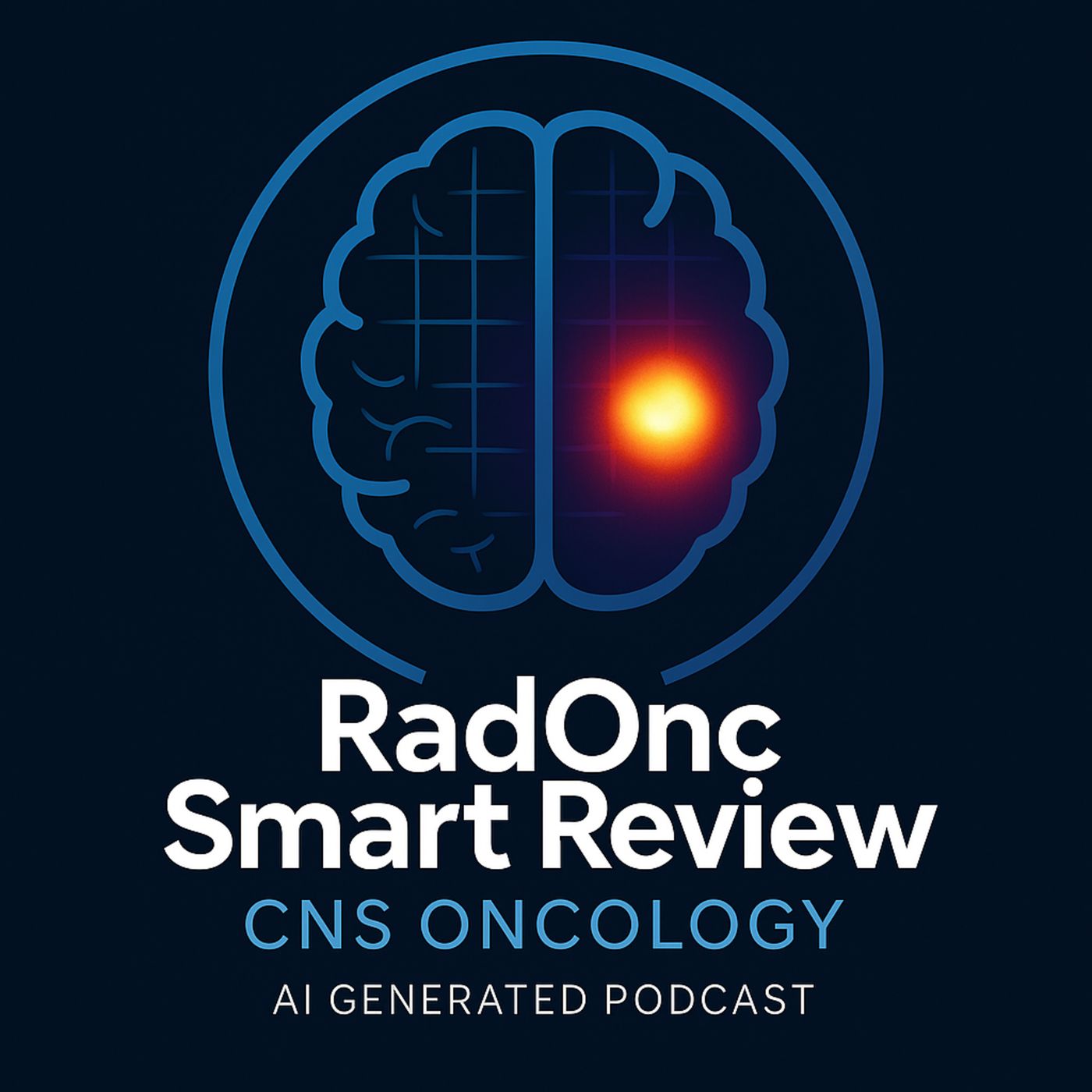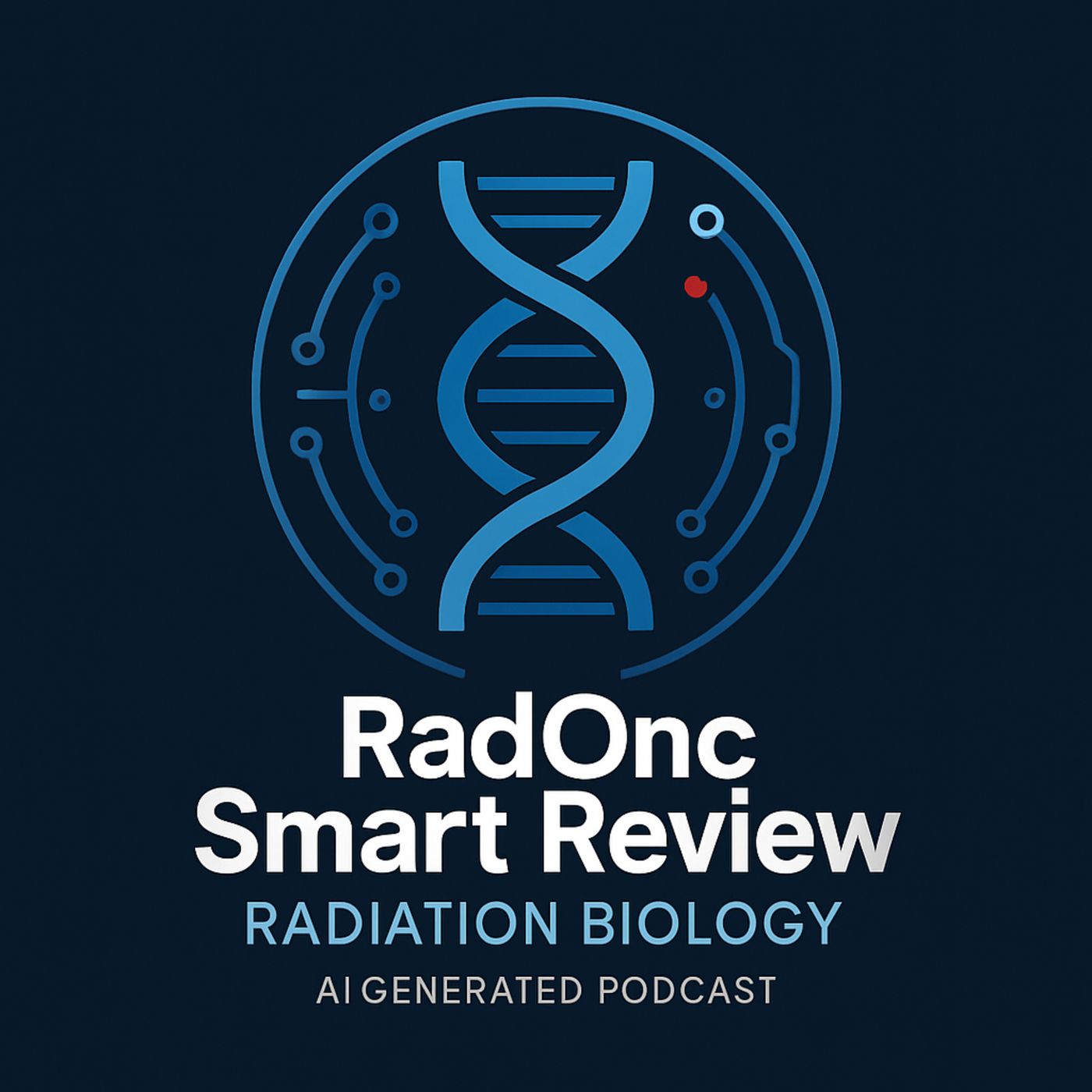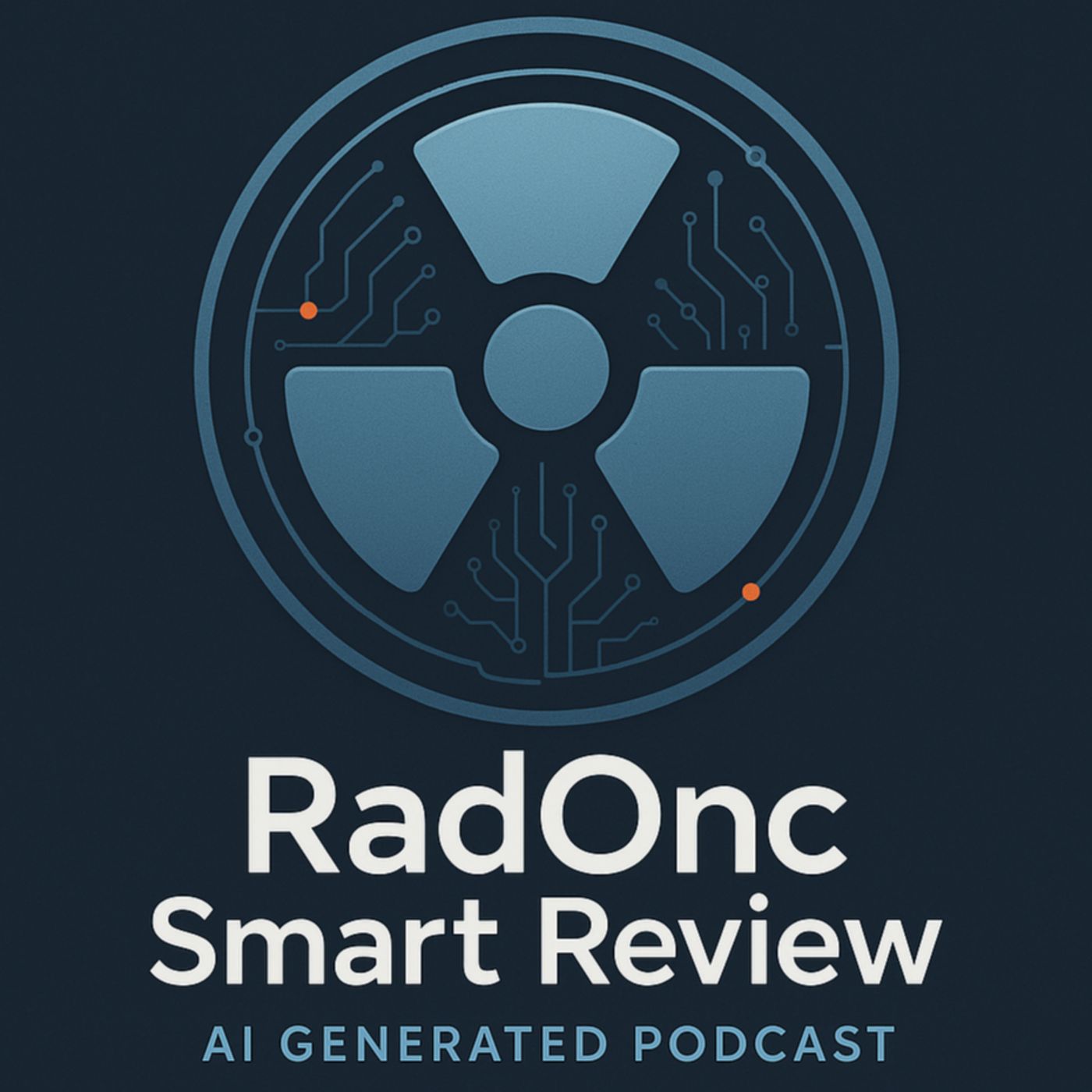RadOnc Smart Review
AI Generated Podcast reviewing various topics in Radiation Oncology for Residents on the go.
CNS E05: HGG Treatment Planning Workshop

In our first four episodes, we've established the "what" and the "why" of high-grade glioma management. Today, we get practical and move to the "how." Treatment planning is a core competency for any radiation oncologist, and for high-grade gliomas, it's a discipline of millimeters and nuanced judgments.
CNS 04: HGG: Special Cases and Advanced Treatments

In our first three episodes, we mastered the standard approach for a "Stupp-eligible" patient with glioblastoma. But as you know, many of our patients do not fit this mold. They are older, have a lower performance status, or present with the formidable challenge of recurrent disease. Today, we address these special cases head-on. We'll build a framework for treating elderly and frail patients, review the evidence for re-irradiation, and discuss the role of the novel technology, Tumor-Treating Fields.
CNS E03: GBM Foundations and The Stupp Protocol

In our first two episodes, we built the modern diagnostic framework for high-grade gliomas, focusing on anaplastic oligodendrogliomas and astrocytomas. Today, we turn our attention to the most common and most formidable of these tumors: glioblastoma, IDH-wildtype. For years, this diagnosis came with a grim prognosis. But in 2005, one trial created a paradigm shift, establishing the bedrock of modern neuro-oncology. We will do a deep dive into the Stupp protocol and explore why, despite nearly two decades of research, it remains our standard of care.
CNS E02: High-Grade Glioma Part 2: Anaplastic Astrocytoma and the Rise of Molecular Grade 4

In our last episode, we established the modern molecular framework for diagnosing high-grade gliomas and detailed the management of anaplastic oligodendroglioma. Today, we explore the other side of that coin. We will master the management of anaplastic astrocytoma by dissecting the pivotal CATNON trial, and we’ll tackle a challenging new entity introduced in the 2021 WHO classification: the IDH-mutant astrocytoma, Grade 4, a tumor that looks lower-grade under the microscope but carries a much graver prognosis based on its genetics.
CNS E01: Modern Glioma Classification and Anaplastic Oligodendroglioma

Welcome back to Rad Onc Smart Review, CNS Edition.T his is Episode 1 of our new series on CNS oncology, titled: Modern Classification & Anaplastic Oligodendroglioma Evidence. For decades, we treated high-grade gliomas based on what a pathologist saw under a microscope. But in the last ten years, a molecular revolution has completely rewritten the textbook. You cannot treat what you can't accurately diagnose, and the modern diagnosis of glioma is now an integrated, molecular one. Today, we will establish this critical diagnostic framework. Then, we will apply it by taking a deep dive into the management of anaplastic oligodendroglioma, synthesizing...
G.I. E20: Anal Cancer Part 2: IMRT, Planning, and Special Populations

In our last episode, we established the foundations of anal cancer therapy, proving that definitive chemoradiation with 5-FU and Mitomycin-C is the organ-preserving standard of care. But while this approach is highly effective, it is also notoriously toxic. The older 3D radiation techniques often led to severe side effects and treatment breaks that compromised outcomes.Today, we focus on the modern "how." We'll explore how IMRT has revolutionized our ability to treat this disease. We'll walk through a detailed, dose-painted IMRT planning workshop. And finally, we'll use a case to discuss the management of special populations you will frequently encounter...
G.I. E19: Anal Cancer Part 1: Anatomy, Foundations, and Modern CCRT

We've arrived at our final primary site in the lower GI tract: anal cancer. In many ways, this disease is the ultimate success story for radiation oncology. It is one of the few solid tumors where we have moved from a paradigm of radical, mutilating surgery to a non-operative, organ-preserving standard of care, with definitive chemoradiation as the backbone. Today, we'll trace the history of this remarkable shift. We’ll start with the fundamentals of anatomy and staging that make anal cancer unique. Then we'll cover the revolutionary Nigro protocol that started it all, and finally, dive deep into the pi...
G.I. E18: Rectal Cancer Part 4: Planning, Re-Irradiation & Final Review

Over the last three episodes, we have constructed the entire modern framework for rectal cancer management. We’ve established when to treat, how to treat, and who to treat with advanced strategies like TNT and immunotherapy. Today, we bring it all to the treatment planning console.This is the practical application episode. We will provide a step-by-step guide to modern rectal cancer contouring based on international consensus. We'll review critical dose constraints you must know. And finally, we will tackle one of the most complex scenarios in our field—using a case to outline a safe and effective approach to pelv...
G.I. E17: Rectal Cancer Part 3: The TNT Revolution & dMMR Management

In our last episode, we established the foundational principles of neoadjuvant radiation, proving that giving RT before surgery is superior and comparing the short-course and long-course approaches. That framework is perfect for standard-risk disease. But for patients with the highest-risk tumors, the primary driver of mortality isn't local failure—it's distant metastases.This reality has sparked a true revolution in rectal cancer care. Today, we dive into that revolution: Total Neoadjuvant Therapy, or TNT. We will define TNT and its rationale, dissect the blockbuster trials that have redefined the standard of care for high-risk rectal cancer, and cover the game-changing ma...
G.I. E16: Rectal Cancer Part 2: Neoadjuvant Foundations

In our last episode, we established the fundamental clinical landscape of rectal cancer—the anatomy, the critical role of MRI in staging, and the surgical revolution of Total Mesorectal Excision. We learned that with high-quality TME, surgeons could dramatically reduce local recurrence. The question then became: could we improve upon this new surgical standard?
G.I. E15: Rectal Cancer Part 1: Anatomy, Staging, and the TME Revolution

If there is one disease site that perfectly illustrates the power of multidisciplinary, evidence-based cancer care, it’s rectal cancer. The evolution of its treatment is a masterclass in how surgery, radiation, and chemotherapy can be integrated to dramatically improve outcomes. But before we can appreciate that evolution, we must master the fundamentals.Today, we lay the groundwork for this entire story. We will use a classic case to walk through the essential workup, the critical anatomy that dictates treatment, modern staging with MRI, and finally, the surgical innovation that changed everything—Total Mesorectal Excision.
G.I. E14: Liver P3: Biliary Cancers & Metastasis Management

Today, we conclude our liver mini-series by tackling these crucial topics.F irst, we’ll cover the evidence-based management for biliary tract cancers—including gallbladder cancer and cholangiocarcinoma—with a focus on the patterns of failure that guide our use of adjuvant radiation. Then, we’ll pivot to one of the most common clinical scenarios we face: treating colorectal liver metastases, discussing the role of SBRT in the context of other local therapies.
G.I. E13: HCC Part 2: SBRT Workshop – Doses, Data & No-Fly Zones

Today, we conduct our SBRT masterclass for HCC. We will make the definitive case for SBRT over other local therapies by citing the key comparative data. We'll detail the evidence for treating high-risk disease like portal vein thrombosis and walk through the critical dosimetric details—ablative doses, the RTOG 1112 de-escalation schema, and the crucial constraints you need to know to treat safely and effectively.
G.I. E12: HCC Part 1: The HCC Toolkit – Staging, IR, and Systemic Therapy

Welcome back to Rad Onc Smart Review, GI Series.T his is Episode 12: HCC Part 1: The HCC Toolkit – Staging, IR, and Systemic Therapy . Hepatocellular carcinoma, or HCC, is a unique beast in oncology. Unlike most cancers where our focus is solely on the tumor, in HCC we are fighting a war on two fronts: the cancer itself, and the often-diseased liver it inhabits. This dual challenge means that staging and treatment decisions are far more complex than just TNM. Today, we're opening up the HCC toolkit. We'll build a comprehensive framework for managing this disease, starting with the essential staging sy...
G.I. E11: Pancreas Part 4: Guideline, Planning & Case-Based Review

Over the last three episodes, we've journeyed through the complex evidence for pancreatic cancer. We’ve dissected the adjuvant debate, explored the neoadjuvant revolution, and held a masterclass on SBRT. Now, it’s time to put it all together. This is our synthesis episode, where we translate the data from landmark trials into practical, actionable plans.We will start by summarizing the key recommendations from the major guidelines. Then, we’ll move into a detailed treatment planning workshop, covering both postoperative conventional planning and modern SBRT. Finally, we'll work through a classic clinical dilemma to solidify your decision-making skills.
G.I. E10: Pancreas Part 3: LAPC & SBRT Masterclass

In our last two episodes, we focused on patients with resectable or borderline resectable pancreatic cancer—those for whom surgery is the ultimate goal. Today, we turn to a different, but equally challenging scenario: the patient with locally advanced, unresectable disease. These are the patients whose tumors are intimately involved with the major blood vessels, taking surgery off the table, but who do not yet have distant metastases. Here, the goals shift from cure to long-term control. This is where radiation therapy, particularly SBRT, has seen its most significant evolution. This is our SBRT masterclass: we’ll cover the data for...
G.I. E09: Pancreas Part 2: The Neoadjuvant Revolution for Resectable & Borderline Resectable Pancreatic Cancer

Welcome back to Rad Onc Smart Review, GI Series. In our last episode, we wrestled with the difficult data for adjuvant therapy, where even after a grueling Whipple procedure, the prognosis remains guarded. This reality has fueled one of the most significant paradigm shifts in modern GI oncology: moving therapy from the postoperative to the preoperative setting. The rationale is simple yet powerful: select the right patients, improve the quality of surgery, and deliver systemic therapy when patients are strongest. Today, we explore this neoadjuvant revolution. We’ll start by defining who is and who is not a surgical candidate ba...
G.I. E08: Pancreas Part 1: The Adjuvant Setting & The Great RT Debate

Welcome back to Rad Onc Smart Review, GI Series. Pancreatic cancer carries one of the most sobering prognoses in oncology. For the small fraction of patients who present with resectable disease, surgery offers the only hope for a cure. But even after a successful resection, the risk of recurrence is incredibly high, making effective adjuvant therapy a critical component of care. For decades, the question of "what to do after surgery" has been one of the most contentious debates in GI oncology, pitting aggressive systemic chemotherapy against the potential local control benefit of radiation.Today, we're going to trace this...
G.I. E07: Gastric Cancer Part 2: Adjuvant RT, Targeted Therapy & Planning

In our last episode, we established that for resectable gastric cancer, high-quality D2 surgery and effective perioperative chemotherapy with FLOT is the modern standard of care. But that raises a critical question for us as radiation oncologists: what is the role of radiation therapy in this disease? Today, we answer that question by dissecting the landmark trials of adjuvant chemoradiation, exploring the use of targeted therapy for HER2-positive disease, and putting it all together in a practical treatment planning workshop.
G.I. E06: Gastric Cancer Part 1, covering Surgery and Perioperative Chemotherapy

Welcome back to Rad Onc Smart Review, where we break down the clinical decisions that matter most in radiation oncology. This is Episode six: Gastric Cancer Part one, covering Surgery and Perioperative Chemotherapy.Gastric cancer remains a major global health challenge. While less common in the United States, it’s the third leading cause of cancer-related death worldwide, often because it's diagnosed at an advanced stage. For decades, the management of resectable disease has been an evolving story, a tug-of-war between more aggressive surgery and more effective systemic therapy. Today, we're going to trace that evolution, starting with the fundamentals of...
G.I. E05: Esophagus Part 4: NOM, Advanced Disease & Treatment Planning

This is Episode 05: Esophagus Part 4: NOM, Advanced Disease & Treatment Planning.This is our capstone episode on esophageal cancer. We’ve covered the fundamentals, the landmark trials, and the modern debates. Today, we bring it all together. We’ll explore the exciting frontier of non-operative management, clarify the algorithm for using immunotherapy in advanced disease, and then roll up our sleeves for a practical treatment planning workshop where we’ll delineate volumes and apply critical dose constraints based on the latest evidence.
G.I. E04: Esophagus Part 3: The Dose Escalation & Adjuvant IO

This is Episode 04: Esophagus Part 3: The Dose Escalation & Adjuvant IO Debates.In our last episode, we laid the foundation with the landmark trials establishing neoadjuvant and definitive chemoradiation. But a key principle in oncology is to always ask: can we do better? Today, we tackle the controversies and innovations that have attempted to improve upon those standards. We’ll dissect the decades-long, and largely disappointing, quest for dose escalation. Then, we’ll pivot to the modern era and explore how adjuvant immunotherapy is revolutionizing outcomes.
G.I. E03: Esophagus Part 2: Neoadjuvant & Definitive CCRT

This is Episode 03: Esophagus Part 2: Neoadjuvant & Definitive CCRT.In our last episode, we laid the groundwork for esophageal cancer management. Now, we move to the heart of the matter: how we treat locally advanced disease. This episode is all about the landmark trials that defined the role of chemoradiation. We'll dissect the two pillars of modern esophageal radiation oncology: RTOG eighty-five-zero-one for definitive treatment, and the CROSS trial for the neoadjuvant setting. We’ll then see how these standards are being challenged by newer chemotherapy regimens.
G.I. E02: Esophagus Part 1: Anatomy, Staging & Surgical Options

This is Episode 02: Esophagus Part 1: Anatomy, Staging & Surgical Options.Getting the fundamentals right in esophageal cancer is everything. It's a disease where anatomy dictates treatment fields, staging dictates modality, and surgical approach dictates potential toxicities. Today, we'll build that crucial foundation, covering the anatomy and workup that drive our initial decisions, the nuances of the latest AJCC staging, and the surgical landscape before we even think about turning on the beam.
G.I. E01: Principles: Re-RT, Toxicity, & Contouring Rare Sites

Welcome back to Rad Onc Smart Review, G.I. Oncology Edition. This is Episode 01: GI Principles: Re-RT, Toxicity, & Contouring Rare Sites.Before we dive deep into specific GI malignancies, we’re going to build a strong foundation. This episode covers four high-yield topics that cut across multiple disease sites: re-irradiation of the pelvis, management of chronic radiation proctitis, contouring inguinal nodes, and treating adrenal metastases. Mastering these principles will set you up for success throughout our entire GI series.
RadBio E39C: Radbio Calculations 1: Quantifying Cell Survival

Welcome back to Rad Onc Smart Review! This is Episode 39C in our special series on Radiobiology Calculations. Today, we’re tackling the mathematics that underpins the very foundation of modern radiation therapy: fractionation. Why do we give many small doses of radiation instead of one big one? The answer lies in the numbers, and mastering these calculations is essential for both your board exams and for safe, effective clinical practice.
RadBio E39B: Radbio Calculations 2 Tumor Control & Kinetics

Welcome back to Rad Onc Smart Review! This is Episode 39B, the second installment of our special series on Radiobiology Calculations. Today, our focus is on Tumor Control & Kinetics. In our last episode, we mastered the calculations for cell survival on a microscopic level. Now, we're scaling up to the macroscopic world of clinical tumors. We'll start by calculating the massive radiation doses required to eradicate billions of tumor cells, connecting this to the concept of Tumor Control Probability, or TCP. We'll then shift gears to explore the dynamics of tumor growth, learning how to relate a tumor's change in...
RadBio E39A: Radbio Calculations 1: Quantifying Cell Survival

Welcome back to Rad Onc Smart Review! This is Episode 39A, and the first in our special series on Radiobiology Calculations. In this episode, Calculations 1: Quantifying Cell Survival, we're moving beyond concepts and getting our hands dirty with the numbers. We'll start with the foundational laboratory data from clonogenic assays and walk step-by-step through calculating Plating Efficiency and Surviving Fraction. Then, we'll master how to apply the Linear-Quadratic model for both acute and low-dose-rate exposures, touch on the classic Target Theory model, and finish with the essential conversion between D₀ and D₁₀.
RadPhysics E18C: RadOnc Board Exam Physics: Essential Review

Today, we're doing a rapid-fire, high-yield review of the absolute must-know concepts, formulas, and numbers for your board exams. We'll move quickly through seven key domains, from fundamental physics to advanced modalities and safety guidelines. Let's begin.
RadPhysics E18B:Radiation Physics overview part 2

Welcome back to our deep dive on the core principles of radiation physics. This is Part B of our comprehensive physics review. In Part A, we built the foundation, exploring everything from the atom and radioactive decay to the complex machines that generate our clinical beams.Exactly. We covered the "what" of radiation. Now, in this episode, we're going to cover the "how." We'll see how we measure, plan, and deliver dose with these beams. We'll get into dosimetry, M.U. calculations, advanced techniques like I.M.R.T. and V mat, and wrap up with crucial concepts in imaging...
RadPhysics E18B: Physics overview

Part 2 of physics overview
RadPhysics E18: Physics overview

Physics overview touching a little of every topic...work in progress.
RadPhysics E17D: Lungs, Seeds, and Safety Shields

This is our final episode focused purely on calculations! We've journeyed from basic decay to complex Monitor Unit calculations. Today, we hit the advanced scenarios: What happens when the beam hits lung or bone? How do we compare radically different fractionation schemes biologically? How does modern brachytherapy dosimetry really work with TG 43? And finally, the essential math for keeping everyone safe from radiation. Today, we’re calculating radiological path length, BED and EQD 2, applying the TG 43 framework with Air Kerma Strength, and ensuring our shielding calculations meet regulatory limits.
RadPhysics E17C: Dose Divers and Electron Escapades

Welcome back to Radiation Oncology Smart Review – Calculation Toolkit Episode 17C: Dose Divers and Electron Escapades. Last time, we calibrated our detectors and nailed Monitor Unit calculations for standard setups. Now, we follow the dose after it leaves the machine head. Today, we'll master transferring dose between different depths using Percent Depth Doses and Tissue Maximum Ratios, untangle the geometric puzzles of skin gaps for field matching, learn the simple scaling rules for field sizes, calculate equivalent squares, and dip our toes into the unique world of electron beam Monitor Unit calculations.
RadPhysics E17B: Dosimetry Detectives and Chamber Charades

Welcome back to Radiation Oncology Smart Review – Episode 17 part B: Dosimetry Detectives and Chamber Charades. Last time, we tackled the ticking clocks of decay and permanent implants. Today, we put on our detective hats to investigate how we actually measure radiation and make sure the right dose goes to the right place. We’ll decode the secrets of ion chambers and their sneaky temperature-pressure dependence, master the Monitor Unit, or M U, calculations for both S A D and S S D setups – the absolute bedrock of clinical physics – figure out how dose changes with depth using P D Ds and T M...
RadPhysics E17a: Calculations 1: Half-Lives and Seed Sleuths

Welcome back to Radiation Oncology Smart Review – the targeted prep for your radiation oncology boards! I’m your guide, diving deep into the calculations that matter. This is Episode 17a of our Calculation Toolkit series, titled Radiation Oncology Calculations 1: Half-Lives and Seed Sleuths. Today we’ll master three bread-and-butter RAPHEX problem families: first, radioactive decay and time-activity puzzles, second, effective half-life mash-ups, and third, permanent implant total-dose questions. By the end you’ll know why lambda keeps physicists up at night, how to find the Goldilocks half-life combining body and physics, and how one sleepy iodine one twenty-five seed still manages...
RadPhysics E16c: PET & Ultrasound Physics for RadOnc

Welcome back to the RadOnc Smart Review Physics Series for our concluding episode! In P16b, we explored the crucial planning modalities of CT and MRI. Today, in Episode P16c: PET & Ultrasound Physics for RadOnc, we round out our imaging tour by looking at two other important technologies: Positron Emission Tomography (PET), which gives us insights into metabolic function, and Ultrasound (US), often used for real-time guidance and visualizing certain structures.
RadPhysics E16b: CT & MRI Physics for RadOnc

Welcome back to the RadOnc Smart Review Physics Series! In P16a, we covered the crucial principles of radiation protection and the regulations governing our field. Now, in Episode P16b: CT & MRI Physics for RadOnc, we dive into the physics behind the two imaging modalities most fundamental to treatment planning: Computed Tomography (CT) and Magnetic Resonance Imaging (MRI). How do they create the detailed anatomical images we rely on every day?
RadPhysics E16a: Radiation Protection & Regulations

Welcome back to the RadOnc Smart Review Physics Series! We've explored how radiation is produced, how it interacts, how we measure it, plan treatments, and ensure quality. Now, we circle back to a fundamental responsibility: radiation safety. In Episode P16a: Radiation Protection & Regulations, we'll review the types of radiation effects, the quantities used to measure risk (Dose Equivalent, Effective Dose), the ALARA principle, the critical regulatory dose limits for workers and the public, and touch upon managing dose from internal radioactivity.
RadPhysics E15c: Brachytherapy QA, Safety & Regulations

Welcome back to the RadOnc Smart Review Physics Series! In E15a, we covered brachytherapy sources and TG-43 dose calculations. In P15b, we looked at clinical applications and planning systems. Now, in our final brachytherapy episode, P15c: Brachytherapy QA, Safety & Regulations, we focus on arguably the most critical aspect: ensuring these procedures are performed safely and accurately, protecting both patients and staff, and complying with strict regulatory requirements.